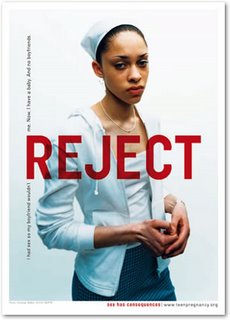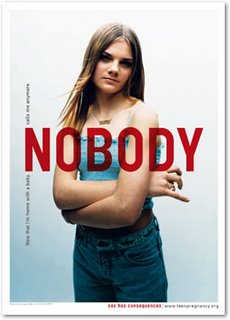I first posted these posters on SocImages in 2008. They are designed to scare teenagers into taking precautions against pregnancy by demonizing teenagers who get (someone) pregnant. The way in which teens are portrayed in these images — labeled cheap, dirty, rejects, pricks, and nobodys — suggests that the organization, the National Campaign to Prevent Teen Pregnancy, doesn’t care about teenagers, only in controlling their behavior.
This is the sentence that runs along the left vertical with the word “reject” extracted in bold: “I had sex so my boyfriend wouldn’t REJECT me. Now, I have a baby. And no boyfriends.”
 “Now that I’m home with a baby, NOBODY calls me anymore.”
“Now that I’m home with a baby, NOBODY calls me anymore.”
 “All it took was one PRICK to get my girlfriend pregnant. At least that’s what her friends say.”
“All it took was one PRICK to get my girlfriend pregnant. At least that’s what her friends say.”
 “Condoms are CHEAP. If we’d used one, I wouldn’t have to tell my parents I’m pregnant.”
“Condoms are CHEAP. If we’d used one, I wouldn’t have to tell my parents I’m pregnant.”
 “I want to be out with my friends. Instead, I’m changing DIRTY diapers at home.”
“I want to be out with my friends. Instead, I’m changing DIRTY diapers at home.”
In response to ads like these, sociologist Gretchen Sisson has started a tumblr of examples of anti-teen pregnancy PSAs that use fear, shame, and threats as motivators, sent to me by @annajobin. Here’s the one I found most stunning; I think it goes something like don’t-drink-and-party-or-you’ll-get-raped-and-pregnant-and-your-life-will-be-horrible-and-oh-your-child-will-become-a-rapist-too:
Here are a set of ads that try to convince women not have (unprotected) sex with their male peers by suggesting that the men showing interest in them are bad guys who will inevitably abandon them:


 And here are a set that use simple threats to get across their message:
And here are a set that use simple threats to get across their message:


 About her tumblr, Sisson writes:
About her tumblr, Sisson writes:
Public service announcements that claim to be about “preventing teen pregnancy” are more frequently about shaming and stigmatizing young parents. This is not a way to encourage young people to take control of their reproductive lives, and it’s certainly not a way to support young families.
Nor is it a way to support teenagers who are negotiating complicated interpersonal terrain and making difficult decisions. These ads are about getting teenagers to do what we want, not helping them figure out what’s best for them. They caricature the actual lives of teenagers and make early parenthood into a comical boogeyman. Moreover, they send a clear message to the teenagers that do get pregnant: “you’re a slut/idiot and your life is over.” This is not good for young parents and it sets them up to fail.
Lisa Wade, PhD is an Associate Professor at Tulane University. She is the author of American Hookup, a book about college sexual culture; a textbook about gender; and a forthcoming introductory text: Terrible Magnificent Sociology. You can follow her on Twitter and Instagram.












